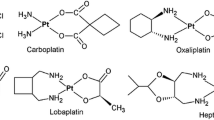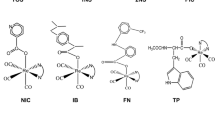Abstract
The platinum complex [meso-1,2-bis(2,6-dichloro-4-hydroxyphenyl)-ethylenediamine]dichloroplatinum(II), K, was tested for its antitumor activity on hormonesensitive tumor models under peroral administration. The resorption from the gastrointestinal tract was proved by determining the estrogenic effect of K in a dose/activity study using the immature-mouse uterine weight test. In comparison to the subcutaneous injection, a tenfold peroral dose was administered to achieve identical effects. By peroral treatment of the hormone-sensitive MXT(M3.2) mammary carcinoma of the mouse with K an almost complete inhibition of the tumor growth was obtained. This effect was superior to that of subcutaneously applied cisplatin and significantly better than that obtained by perorally administered ligand L at an equimolar dose, indicating that the antitumor effect is caused by the intact complex K and not by the liberated ligand L. The strong antitumor activity of perorally applied K was also demonstrated on the hormone-sensitive Noble Nb-R prostatic carcinoma of the rat. Histological examinations showed that the platinum complex K did not cause cisplatin-like kidney damage or irritations of gastric or intestinal mucosa when given perorally.
Similar content being viewed by others
Abbreviations
- DMBA:
-
dimethylbenz[a]anthracene
- ER:
-
estrogen receptor
- K:
-
complex
- [meso-1,2-bis(2,6-dichloro-4-hydroxyphenyl:
-
(ethylenediamine]dichloroplatinum(II)
- L:
-
ligand:meso-1,2-bis(2,6-dichloro-4-hydroxyphenyl)ethylenediamine
- LM:
-
1∶1 mixture (v/v) of polyethyleneglycol 400 and 1.8% NaCl
- PEG:
-
polyethylene glycol
References
Bednarski PJ, Trümbach B, Kratochwil NA, Schönenberger H (1992) Diamine ligand release from the cisplatin analogue [meso-1,2-bis(2,6-dichloro-4-hydroxyphenyl)-ethylenediamine]dichloroplatinum(II) in cell culture medium. J Med Chem 35:4479–4485
Bernges F, Holler E (1991) The reaction of pllatinum(II) complexes with DNA. Kinetics of intrastrand crosslink formation in vitro. Nucleic Acids Res 19:1483–1489
Bernges F, Holler E (1992) Ring-substituted diaqua(1,2-diphenylethylenediamine)platinum(II) sulfate reacts with DNA through a dissociable complex. Eur J Biochem 208:573–579
De Vita VT Jr, Hellman S, Rosenberg SA (1989) Cancer principles and practice of oncology, 3rd edn. Lippincott Philadelphia, p 1050
Drago JR, Goldman LB, Gershwin ME (1980a) Chemotherapeutic and hormonal considerations of the Nb rat prostatic adenocarcinoma model. Prog Clin Biol Res 37:325–363
Drago JR, Goldman LB, Maurer RE (1980b) The Nb rat prostatic adenocarcinoma model system. Prog Clin Biol Res 37:265–291
Gust R, Schönenberger H, Klement U, Range KJ (1993) Aqua[1-(2,6-dichloro-4-hydroxyphenyl)-2-phenylethylenediamine]sulfatoplatinum(II) complexes with variable substituents in the 2-phenyl ring. Part II. Correlation of molecular structure and estrogenic activity of breast and prostate cancer inhibiting [erythro-1-(2,6-dichloro-4-hydroxyphenyl)-2-(2-halo-4-hydroxyphenyl)ethylenediamine]platinum(II) complexes. Arch Pharm (Weinheim) (in press)
Hacker MP (1991) Toxicity of platinum-based anticancer drugs. In: Powis, G, Hacker MP (eds) The toxicity of anticancer drugs. Pergamon, New York, pp 82–105
Haddow AL, Watkinson JM, Patterson E, Koller E (1944) Influence of synthetic oestrogens upon advanced malignant disease. Br Med J 2:393–398
Handelsman M, Goldsmith H, Broder L, Carter S, Slarik M (1976) Clinical brochure. Natl Cancer Inst Monogr 1: 10
Harrap KR, Murrer BA, Giandomenico C, Morgan SE, Kelland LR, Jones M, Goddad PM, Schurig J (1991) Ammine/amine platinum IV dicarboxylates: a novel class of complexes which circumvent intrinsic cisplatin resistance. In: Howell SB (ed) Platinum and other metal coordination compounds in cancer chemotherapy. Plenum, New York, pp 391–399
Hartley-Asp B, Kruse E (1986) Nuclear protein matrix as a target for estramustine induced cell death. Prostate 9: 387–395
Hartmann RW (1983) Tumor growth-stimulating and inhibiting effects of antiestrogens on the DMBA-induced mammary carcinoma of the ovariectomized, diethylstilbestrol-treated SD-rat. A study on the mechanism of action of antiestrogens. Eur J Cancer Clin Oncol 19:959–964
Hartmann RW, Kranzfelder G, Angerer E von, Schönenberger H (1980) Antiestrogens. Synthesis and evaluation of mammary tumor inhibiting activity of 1,1,2,2-tetraalkyl-1,2-diphenylethanes. J Med Chem 23:841–848
Hartmann RW, Schönenberger H, Wrobel K-H (1982) 3,4-Bis-(3-hydroxyphenyl)hexane — a new mammary tumor-inhibiting compound-studies on the mechanism of action on the DMBA-induced, hormone-dependent mammary tumor of the rat. J Cancer Res Clin Oncol 103:241–254
Hartmann RW, Sinchai T, Kranzfelder G (1985) Antiproliferative effects of 1,2-diphenylethane effects of 1,2-diphenylethane estrogens and antiestrogens on human breast cancer cells. J Cancer Res Clin Oncol 110:17–24
Hasegawa Y, Morita M, Muto N (1980) Antitumor activity of cisplatin on experimental animal system. Jpn J Cancer Chem 7:621–630
Hasegawa Y, Masuguki M (1985) Antitumor effect of oral cisplatin on certain murine tumors. Chem Pharm Bull (Tokyo) 33:5511–5514
Holler E, Bauer R, Bernges F (1992) Monofunctional DNA-platinum(II) adducts block frequently DNA polymerases. Nucleic Acid Res 20:2307–2312
Humm A (1988) Synthese und biologische Testung nichtsteroidaler Antiandrogene und Untersuchungen am Nb-R Prostatakarzinom der Noble-Ratte. PhD thesis, University of Regensburg
Janistyn H (1978) Handbuch der Kosmetika und Riechstoffe, Vol. 1. Hüthig, Heidelberg, p 731
Karl JF-X (1985) Versuche zur Entwicklung Östrogenrezeptor-affiner Platinkomplexe mit einer spezifischen Wirkung am hormonabhängigen Mammacarcinom. PhD thesis, University of Regensburg
Karl J, Gust R, Spruß T, Schneider M, Schönenberger H, Engel J, Wrobel KH, Lux F, Trebert-Haeberlin S (1988) Ring substituted [1,2-bis(4-hydroxyphenyl)ethylenediamine]dichloroplatinum(II)-complexes: compounds with a selective effect on the hormone-dependent mammary carcinoma. J Med Chem 31:72–83
Koop R (1992) Molekulare Wirkmechanismen von Antiestrogenen und Estrogenrezeptor-affinen Platin(II)-Verbindungen. PhD thesis, University of Regensburg
Maron DM, Ames BN (1983) Revised methods for theSalmonella mutagenicity test. Mutat Res 113:173–215
Maucher A (1992) Pharmakologische Untersuchungen über neue Möglichkeiten zur endokrinen und cytostatischen Behandlung des Prostatakarzinoms. PhD thesis, University of Regensburg
Montemurro DG (1971) Inhibition of hypothalamic obesity in the mouse with diethylstilbestrol. Can J Physiol Pharmacol 49:554–558
Otto AM, Faderl M, Schönenberger H (1991) Dissociation of estrogenic and cytotoxic properties of an estrogen receptor-binding platinum complex in human breast cancer cell lines. Cancer Res 51:3217–3223
Otto AM, Bednarski PJ, Eggers H, Trümbach B, Schönenberger H (1992) [meso-1,2-bis(2,6-dichloro-4-hydroxyphenyl)-ethylenediamine]dichloroplatinum(II), an estrogenic Pt(II)-complex for the therapy of breast cancer: relationship between stability and effect. Pharm Pharmacol Lett 1:103–106
Prestayko AW, Crooke ST, Carter SK (1980) Cisplatin current status and new developments. Academic Press, NY
Reile H, Bernhardt G, Koch M, Schönenberger H, Hollstein M, Lux F (1992) Chemosensitivity of human MCF7 breast cancer cells to diastereomeric diaqua(1,2-diphenylethylenediamine)platinum (II) sulfates and specific platinum accumulation. Cancer Chemother Pharmacol 30:113–122
Rubin BL, Dorfman AS, Black L, Dorfman RJ (1951) Bioassay of estrogens using the mouse uterine response. Endocrinology 49:429
Schiller CD (1988) Synthese und biologische Testung nichtsteroidaler Antiandrogene und Untersuchungen zum Wirkungsmechanismus neuer Prostatakarzinom Therapeutika an R 3327 Tumormodellen. PhD thesis, University of Regensburg
Schneider MR, Kranzfelder G, Angerer E von, Schönenberger H, Metzler M, Michel RT, Fortmeyer HP, Ruckdeschel G (1981) The tumor inhibiting effect of diethylstilbestrol-3,4-oxide. J Cancer Res Clin Oncol 100:247–254
Schneider MR, Ball H, Schönenberger H (1985) Acetoxy-substituted 1,1,2-triphenylbut-1-enes with antiestrogenic and mammary tumor inhibiting properties. J Med Chem 28:1880–1985
Schneider MR, Angerer E von, Prekajac J, Brade WP (1986) Studies on the mammary tumor-inhibiting effects of diethylstilbestrol and its mono- and diphosphate. J Cancer Res Clin Oncol 111:110–114
Schneider MR, Spruß T, Schiller CD, Humm A, Schönenberger H (1988). Selective prostatic tumor inhibiting effect of an endocrine active platinum complex. In: Bresciani F, King RJB, Lippman ME, Raynaud JP (eds) Progress in cancer research and therapy, vol 35. Hormones and cancer. Raven Press, New York, p 509
Schneider MR, Schiller CD, Humm A, Spruß T, Schönenberger H, Amselgruber W, Sinowatz F (1989) [1,2-Bis(2,6-dichloro-4-hydroxyphenyl)ethylenediamine]-dichloroplatinum(II): an endocrine-active platinum complex with a specific prostatic tumor-inhibiting activity. Prostate 15:135–148
Schneider MR, Humm A, Graf AH (1990) The tumor-inhibiting effect of diethylstilbestrol and its diphosphate on the Nb-H and Nb-R prostatic carcinomas of the rat. J Cancer Res Clin Oncol 116:159–167
Seeger R, Neumann HG (1986) DAZ-Giftlexikon: platin. Dtsch Apoth Ztg 126:157–160
Siddik ZH, Newell DR, Boxall FE, Jones M, McGhee KG, Harrap KR (1984) Biliary excretion, renal handling and red cell uptake of cisplatin and CBDCA in animals. In: Hacker MP, Douple EB, Krakoff IH (eds) Platinum coordination complexes in Cancer chemotherapy. Martinus Nijhoff, Boston
Smyth HF Jr, Carpenter CP, Shaffer BC (1945) The subacute toxicity and irritation of polyethylene glycols of approximate molecular weights of 200, 300 and 400. J Am Pharm Assoc Sci Ed 34:172–174
Smyth HF Jr, Carpenter CP, Weil CS (1950) The toxicology of polyethylene glycols. J Am Pharm Assoc Sci Ed 39:349–354
Spruß T (1988) Modelle zur Untersuchung von Platinkomplexen mit hormoneller und zytotoxischer Aktivität. PhD thesis, University of Regensburg
Spruß T, Gust R, Müller R, Engel J, Schönenberger H (1990) Mammary tumor inhibiting properties of the (S,S)-configurated [1,2-bis(4-hydroxyphenyl)ethylenediamine]dichloroplatinum(II) complex. Arch Pharm (Weinheim) 232:99–102
Spruß T, Bernhardt G, Schlemmer R, Schönenberger H (1992) Differing responses of hormone-dependent rodent tumors grown in immunodeficient and immunocompetent hosts to hormone-like therapy. Contrib Oncol 42:397–407
Wolpert-De Filippes MK (1979) Antitumor activity ofcis-dichlorodiammineplatinum(II). Cancer Treat Rep 63:1453–1458
Author information
Authors and Affiliations
Rights and permissions
About this article
Cite this article
Spruß, T., Schertl, S., Schneider, M.R. et al. [meso-1,2-Bis(2,6-dichloro-4-hydroxyphenyl)ethylenediamine]-dichloroplatinum(II), a new drug not only parenterally but also orally active in the therapy of breast and prostate cancer. J Cancer Res Clin Oncol 119, 707–716 (1993). https://doi.org/10.1007/BF01195341
Received:
Accepted:
Issue Date:
DOI: https://doi.org/10.1007/BF01195341




